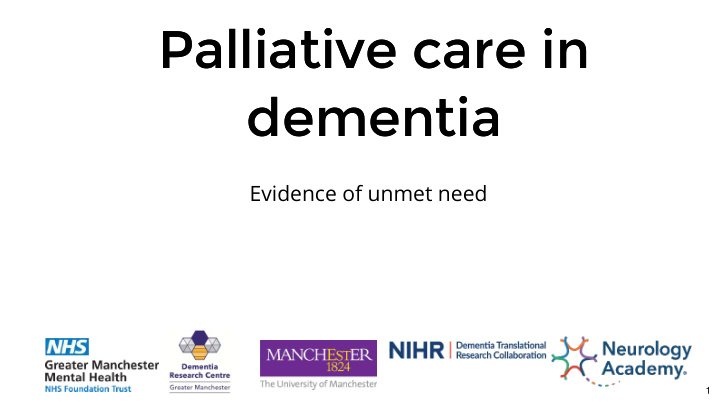



Palliative care in Palliative care in dementia dementia Evidence of unmet need 1
Overview Overview Barriers to care Economic Knowledge Communication Variation in care Personal perspective 2
https://www.ons.gov.uk/peoplepopulationandcommunity/healthandsocialcare/healthcaresystem/bulletins/nationals 3 urveyofbereavedpeoplevoices/england2015
VOICES 2015 VOICES 2015 n = 21,073 4
VOICES 2015 VOICES 2015 5
VOICES 2015 VOICES 2015 6
VOICES 2015 VOICES 2015 Quality of care by settings (Q19, Q23, Q28a, Q28b) 7 . 1
VOICES 2015 VOICES 2015 7 . 2
VOICES 2015 VOICES 2015 7 . 3
Sleeman et al 2014 Sleeman et al 2014 Care home bed provision and living in an area of least deprivation were the most important factors associated with care home death. 8
Sleeman et al 2014 Sleeman et al 2014 among people with a death certificate mention of dementia, hospital deaths remain amongst the highest in developed countries, with two in five people dying in hospital 9
2016, found only 2 RCTs. Measured 30 outcomes but failed to measure the same outcome 10
Place of death Health resources 11
12
13
Dementia in the acute hospital: prospective cohort study of prevalence and mortality EL Sampson, MR Blanchard, L Jones, A Tookman… - The British Journal of Psychiatry, 2009 14
Sampson et al 2006 Sampson et al 2006 1. 30% of those with dementia received palliative medications v 50% of those with other conditions 2. 9% were referred to PC team, versus 25% with other conditions 15
Commissioned by Marie Curie - inc Voices data and lit review 16 . 1
Identified barriers to good PC in PwD 1. people with dementia have symptoms that are commonly not effectively addressed and 2. dying phase may frequently go unrecognised : Rowlands and Rowlands (2012) Birch and Draper (2008) 3. Less predictable course of late illness (van der Steen 2013) 4. 71% of USA NH residents expected to live 6/12 died within that period (Bayer) 5. USA: Those with primary diagnosis of dementia more likely to outlive Medicare prognostic models (Rothenberg 14) 6. "Controversiality" (LCP) 7. Communication and ethical / legal misunderstanding leadign to overly aggressive intervention 16 . 2
16 . 3
n=85, 38% died < 40% had ACP 24% did not have DNACPR but only 7% of those who died ++ Paramedic contact ++ GP contact Little Geri / OAPsych contact 17
14 HCP One hour interviews Public & Private settings Various professions Thematic analysis We sought to explore service personnel’s recognition of dementia as a life-limiting illness, the management of acute medical problems, appropriateness of hospitalisation, the role of advance care plans and do not attempt resuscitation orders and HCPs views of where the health and social care system is failing to meet the needs of people with advanced dementia and their families. The researchers used emerging information to explore significant and unanticipated issues in later interviews. 18 . 1
18 . 2
By law it should be five to one [ratio of care staff to residents]. So the extra five, I chipped in most times to assist. And I work on the floor . . . [Why do you think you’re understaffed at the moment?] From my experience - its right across the whole country, you never get enough staff in. It’s only, occasionally you might have three carers to support you, but most of the time, the shortness of the adequate personnel is a crisis . . . Well, I do believe that one of the reasons is cost effectiveness. Not cost effectiveness - it’s got to do with finance. Not finance in the sense that, it’s [care homes] a profit making organisation, that doesn’t make it easy. And the less staff you get to carry out the task, the more profit you make (Mental Health Nurse). 18 . 3
A strongly held view was that care homes were ill equipped to provide adequate end of life care for residents with dementia. Due to the profit-driven nature of care homes, respondents reported that staffing levels were poor, and staff turnover was high due to limited professional development opportunities, demanding workloads, low pay and low job satisfaction resulting in high levels of role burden. Low availability of both trained & untrained staff. 18 . 4
1. 1,047 people who died with dementia 2. preferred v actual place of death available for 803 3. care home (58.8%, n = 472) 4. home (39.0%, n = 313) 5. 83.7% ( n = 672) died in their preferred place 6. Dying in the preferred place was more likely for those most functionally impaired (OR 1.82 95% CI 1.06–3.13), and with a ceiling of treatment of ‘symptomatic relief only’ (OR 2.65, 95% CI 1.37– 5.14). Coordinate My Care, an Electronic 7. It was less likely for people with a primary diagnosis of cancer (OR 0.52, 95% CI 0.28–0.97), Palliative Care Coordination System. those who were ‘for’ cardio-pulmonary resuscitation (OR 0.32, 95% CI 0.16–0.62) and those whose record was created longer before death (51–250 days (ref <50 days) OR 0.60, 95% CI 0.38–0.94) 19 . 1
Advanced care plan but Update it Be specific Write down your wishes Discuss the reality of CPR 19 . 2
Greater Manchester Greater Manchester 20
LHCRE LHCRE Frailty Dementia Palliative Care 21
LHCRE LHCRE One record Web access Paramedics Caregiver portal (tech/wearables) Care home GP ED Palliative care team (ACP) 22
discussion discussion 23
Recommend
More recommend